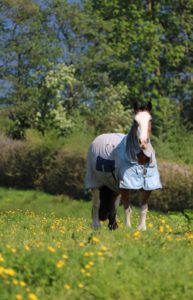Managing Fly and Midge Irritation
June 30, 2020
Flies and midges are the most obvious external irritants affecting horses and ponies during summer. Many horses and ponies find flies extremely irritating, both mentally and physically, and will struggle to concentrate on their work or become distressed and charge around the field in an effort to escape the almost constant harassment. Managing the level of irritation is key to keeping animals happy and healthy and enabling them to perform the work asked of them.
Flies are particularly attracted to the horses head and often gather around the moist areas of the eyes, nose and mouth, causing some horses to headshake and an increased risk of eye infections. Biting flies focus more on the thin skinned, sensitive areas of the horse’s body where they bite the skin and cause painful lumps and swellings. More sensitive horses and ponies develop large swellings that weep and are at an increased risk of infection. If these bites occur in areas where tack is fitted, riding is not recommended until the irritation has reduced and the area has healed.
The Culiciodes midge is responsible for the skin condition called Sweet Itch. The midge bites the horse’s skin and the saliva triggers an allergic reaction causing intense itching and skin irritation. Not all horses and ponies react to the Culiciodes midge saliva, explaining why only some animals develop Sweet Itch despite exposure to the same environment and similar management practices.
Strategies for Managing Fly and Midge Irritation
 Topical deterrents for flies are a summer essential although it can be difficult to provide round the clock protection as effectiveness of such applications can wear off after a few hours. Fly repellents containing DEET (Diethyl-m-toluamide) are generally thought to be more effective at repelling insects than those without this ingredient and are offered by a number of companies in both spray and gel form. It is recommended to test a small patch of your horse’s skin for any adverse reactions before using any insect repellent all over the body. This will allow you to assess if your horse is sensitive to specific ingredients.
Topical deterrents for flies are a summer essential although it can be difficult to provide round the clock protection as effectiveness of such applications can wear off after a few hours. Fly repellents containing DEET (Diethyl-m-toluamide) are generally thought to be more effective at repelling insects than those without this ingredient and are offered by a number of companies in both spray and gel form. It is recommended to test a small patch of your horse’s skin for any adverse reactions before using any insect repellent all over the body. This will allow you to assess if your horse is sensitive to specific ingredients.
Fly rugs provide a physical barrier between the horse and the flies, helping to reduce the area of skin exposed and the likelihood of being bitten, particularly in the area where the saddle fits. If your horse suffers from Sweet Itch it is important to check the rug is also effective in preventing midge bites as not all fly rugs prevent access by the smaller midge. Most fly rugs are designed to be breathable and suitable to wear in all weathers, making them an easy to use and practical way of managing fly irritations. All horses and ponies wearing fly rugs should be checked all over their body at least once per day to ensure the rug is not rubbing and for general signs of good health.
Stable management routines can greatly reduce exposure to fly and midge irritations. Flies and midges are more prevalent at dawn and dusk and near water and trees. If possible horses and ponies should be turned out in fields away from ponds, streams and wooded areas. It is also advisable to turn horses out into exposed fields with strong winds as it is more difficult for the insects to land. Stabling animals at dawn and dusk also reduces exposure to flies and midges as they are less inclined to enter dark spaces. Stabling does allow horses and ponies that have been bitten to rub and scratch more although soothing lotions and balms can help to reduce irritations and the rubbing response. It is also best to keep stables and fields free from droppings and soiled bedding as this will also reduce the number of flies attracted to the area and help control irritation levels.
